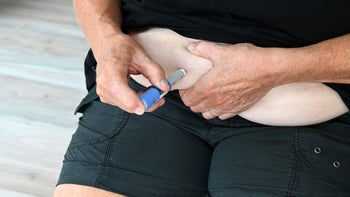
Ozempic Dosages: Your GoodRx Guide
Key takeaways:
Ozempic (semaglutide) is a once-weekly injectable glucagon-like peptide-1 (GLP-1) agonist medication. It’s used to treat Type 2 diabetes in adults. It can also lower the risk of serious cardiovascular and kidney problems in certain people.
The starting dose of Ozempic is 0.25 mg injected once weekly for 4 weeks. Then, your dose is moved up to 0.5 mg once weekly. After that, your dose may be increased every 4 weeks up to 2 mg once weekly, depending on how you respond to the medication.
There are many ways to save on Ozempic. If you’re eligible, a manufacturer savings card can help you access Ozempic for as little as $25 per month. A patient assistance program is also available.
Table of contents

Ozempic (semaglutide) is a popular injectable Type 2 diabetes medication, with added cardiovascular and kidney benefits for certain people. And if you’re new to the medication, understanding the Ozempic dosage schedule is key to using it safely and effectively.
But Ozempic’s dosage isn’t one-size-fits all. You’ll typically start at a low dose that’s gradually increased, depending on how your body responds and your treatment goals. It’s also possible that your prescriber may want you to take Ozempic differently, such as if you’re taking it off-label for weight loss.
So, what’s the typical Ozempic dose, and how often do you take it? Here’s what you should know about Ozempic dosages and what to do if you miss your dose.
Save every month on GLP-1 meds with GoodRx
Save an average of $235 on FDA-approved GLP-1s like Ozempic and Zepbound.

What’s the typical Ozempic dosage?
Ozempic comes as a pre-filled pen. You’ll inject it once weekly just under the skin — in the abdomen, thigh, or upper arm. Meal timing doesn’t affect your dose. So, choose a day and time that’s convenient for you. But be sure to stick with the same day each week.
The starting Ozempic dosage is usually 0.25 mg once weekly. This dose isn’t intended to have an effect on your blood glucose (sugar). Instead, it’s meant to help your body start adjusting to side effects such as nausea. After that, your dose is increased every 4 weeks to the most effective one for you.
Typical Ozempic dosing schedule:
Weeks 1 to 4: 0.25 mg injected once weekly for 4 weeks
Weeks: 5 to 8: 0.5 mg injected once weekly for 4 weeks
Weeks 9 to 12: 1 mg injected once weekly for 4 weeks (optional)
Week 13 and beyond: 2 mg injected once weekly (optional)



For Type 2 diabetes, your typical Ozempic dosage will likely be between 0.5 mg and 2 mg once weekly (the maximum dose). If you have diabetes and chronic kidney disease, the recommended maintenance dosage is 1 mg weekly. Your prescriber will give you instructions on how much to inject each week. Follow the directions given to you, which may be different from those provided above.
Wegovy is another medication that contains semaglutide. But it’s not intended to treat diabetes.
Instead, it’s used for weight loss in people with or without Type 2 diabetes. The highest Ozempic dosage is 2 mg weekly, whereas Wegovy goes up to 2.4 mg once weekly.
Good to know: If you receive a compounded version of Ozempic, you’ll be given a specific set of instructions to follow for your dose. Compounded semaglutide usually comes in a vial, which means you need to measure and draw up your own dose using a syringe.

How many doses are in an Ozempic pen?
Ozempic comes in three different pens that each deliver specific doses:
A red pen (0.25 mg and 0.5 mg)
A blue pen (1 mg)
A yellow pen (2 mg)
When you start Ozempic, there are six doses in the first pen you receive. This includes four 0.25 mg doses and two 0.5 mg doses. In line with the dosing schedule mentioned above, the four 0.25 mg doses will cover the first 4 weeks of treatment. After that, you’ll have 2 weeks of the higher 0.5 mg dose left in the pen.
Each new Ozempic pen after that should contain four doses. Specifically, this includes the 0.5 mg, 1 mg, and 2 mg maintenance doses. Each pen should last 4 weeks (about 1 month).
Are there any dosage adjustments for medical conditions?
If you have kidney problems, your Ozempic dosage doesn’t need to be adjusted. The same is true if you have liver problems.
How to save: Glucagon-like peptide-1 (GLP-1) medications like Ozempic don’t need to break the bank. Explore ways to save on your prescription with this GLP-1 savings guide.
Ozempic injection tips: Is there a best place to inject Ozempic? Here are pharmacist-backed tips for Ozempic injections.
Ozempic side effects: Do you feel nauseated after injecting Ozempic? Learn about potential Ozempic side effects and ways to manage them.
Ozempic has proven kidney-related benefits. While rare, acute kidney damage has been reported in some people using it. Most cases have involved those experiencing fluid loss and dehydration from side effects, which can make kidney function worse. Be sure to keep hydrated, especially if you’re losing fluids.
Tell your healthcare team if your side effects are persistent or severe. Keep up with all of your appointments since they may want to monitor your kidney health during treatment.
What happens if you miss a dose of Ozempic?
If you miss your weekly dose of Ozempic, take it as soon as you remember. If your next dose is less than 48 hours away, skip the missed dose and wait for your regularly scheduled time.
You shouldn’t take two doses of Ozempic within 48 hours of each other. Doing so could result in too much medication in your body. If this happens, your blood glucose could drop too low. And you may be more likely to experience side effects, too. More on that later.
While a once-weekly dose can be convenient, you may find yourself forgetting to take your dose on time. If this sounds like you, medication reminder apps or calendar alerts can help keep you on track. There are also many other creative ways to remember your Ozempic dose.
Can you change your Ozempic injection day?
Yes, it’s possible to change your Ozempic injection day.
Let’s say you want to move your Ozempic injection to a different day of the week. This can be safely done, as long as your last dose was taken 2 or more days before.
For example, if you normally take Ozempic on a Monday, you could move it to Wednesday or any day after that. But remember that there should always be at least 48 hours between doses.
If you want to change your injection day, it’s best to double-check with your healthcare team first. They can help you make the change safely.
What should you do if you take too much Ozempic?
If you take too much Ozempic, you may experience nausea and/or vomiting. You may also have other digestion-related side effects, such as bloating or abdominal pain. Keep in mind that Ozempic lasts a long time in the body, so it can take a while for these effects to resolve.
Too much Ozempic can also lead to low blood glucose (hypoglycemia). If this happens, you may feel shaky, weak, or sweaty. Nausea, hunger, and confusion are also possible. Make sure you know how to identify and treat hypoglycemia quickly if it occurs.
If you think you’ve taken too much Ozempic, contact your healthcare team or call Poison Control at 1-800-222-1222 for guidance. If any side effects feel severe or life-threatening, go to the nearest ER.
Good to know: If you receive a compounded version of Ozempic in a vial, there’s a greater risk of injecting too much. Closely follow the instructions you’ve been given to help prevent errors.
How to save on Ozempic
There are ways to save on Ozempic, which is only available as a brand-name medication. GoodRx can help you navigate between copay savings cards and patient assistance programs to save money on your prescription.
Save with a copay savings card. If you have commercial insurance, you may be eligible to pay as little as $25 for Ozempic using a savings card from the manufacturer.
Save with patient assistance programs. If you’re uninsured or underinsured, you may be eligible for Ozempic’s patient assistance program, which offers the medication free of cost.
Frequently asked questions
You can inject Ozempic at any time of day, but be sure to stick with the same day each week. There’s no “best” time to inject Ozempic. Just pick a time of day that works best for your routine.
Generally, yes. Ozempic isn’t approved for weight loss, but some people lose weight while using it. Higher doses tend to result in greater weight loss. Currently, the highest available Ozempic dose is 2 mg. Wegovy, which also contains semaglutide, goes up to 2.4 mg.
There aren’t specific drugs that need to be avoided altogether with Ozempic. Most Ozempic interactions can be managed with dosage adjustments or additional monitoring. Examples of potential Ozempic interactions include:
Sulfonylureas, such as glipizide
Meglitinides, such as nateglinide
Oral medications
The bottom line
Ozempic (semaglutide) is a once-weekly injection for Type 2 diabetes. It can also lower the risk of cardiovascular and kidney problems in certain people. You’ll typically start with a low Ozempic dose at first to give your body time to adjust to the medication. Then, the dose is usually raised every 4 weeks to get to the right dose for you.
If you have any questions about your Ozempic dosage, talk to your prescriber or pharmacist.
Why trust our experts?


References
Novo Nordisk. (2023). Ozempic (semaglutide) injection, for subcutaneous use [package insert].
Was this page helpful?
Related Articles
Browse medications
View AllResearch prescriptions and over-the-counter medications from A to Z, compare drug prices, and start saving.

























